
In 2014, 26-year-old RS Deeren was an aspiring writer attending Columbia College, living in Ravenswood, and so poor that he was stealing tuna cans from his roommate to cook for dinner when he received notice that he won a fellowship from the Luminarts Cultural Foundation.
“I was kind of a cliche,” Deeren told the Chicago Sun-Times. “It was the first time that somebody other than a school said, ‘You’re a writer, we believe in you,’ and the money was very nice at the time.”
Deeren’s tale may be one of the more dramatic ones from artists who have won Luminarts fellowships over the last decade, but several talked to the Sun-Times about how the foundation helped them both monetarily and provided opportunities that led to their careers flourishing.
On Oct. 1, the Luminarts Cultural Foundation will celebrate 10 years of providing money and support to Chicago-based artists, at a dinner at the Arts Club at Chicago. Along the way, more than $2 million has gone to more than 200 fellows, along with countless networking opportunities that many have taken advantage of, according to executive director Jason Kalajainen.
Chicago-based cellist Alexander Hersh said he was a young musician with limited experience and lots of chutzpah when Luminarts first supported him.
“I had an idea for a chamber music festival called Nexus Chamber Music when I was 24, and they went for it,” said Hersh, who won a fellowship in 2016 and then got a project grant for his music festival a year later.
“They believed in me and have believed in so many other artists and that’s so validating and incredible. Because of that initial grant we are now in our fifth year [and returned to] Ravinia and [the classical music incubator] Guarneri Hall with the festival this year,” Hersh said.
While the foundation has been around since 1949, originally founded as the Union League Civic & Arts Foundation (CAF), the Luminarts Cultural Foundation was created by members of the Union League Club of Chicago as a separate, not-for-profit organization. For years, the foundation supported artists with one-time monetary awards, but it wasn’t until 10 years ago that the organization decided to focus its financial and other resources on helping boost an artist’s career, Kalajainen said.
Luminarts typically receives between 400 and 500 applicants a year for 20 fellowships, and the three criteria are that the applicant has to be between 18 and 30 years old when they apply; they have to live within 150 miles of downtown Chicago at the time they apply, and they either have to be enrolled in or have graduated from a degree program, Kalajainen said.
The fellows are judged by professionals in fields that include visual arts, jazz and classical music and creative writing. Additionally, because of a collaboration with the Joffrey Ballet, one ballet fellow is awarded per year. Similarly, one collaboration with the School of the Art Institute allows for one fashion designer, and a collaboration with the Institute of Classical Architecture and Art allows one architect to be selected per year, Kalajainen said. Fellows are awarded a check in an amount ranging from $5,000 to $15,000 and are also eligible to apply for additional project grants.

Throughout the last decade, Luminarts has awarded more than 200 fellows, and a map of the geographic reach of the group’s awards looks like an airline map of cities serviced, with lines emanating from Chicago to all over Europe, Asia, the Middle East and Australia.
Luminarts is funded with a government endowment, private donations, fundraisers and a historic relationship with the Union League Club of Chicago — whose members Kalajainen likened to “artistic venture capitalists.”
“They’re certainly donors, but they’re also investing money in these young, incredibly talented people because they want their wonderful art to be at the museums they go to and have their books in the libraries they patronize,” Kalajainen said.
But more than money, Luminarts provides networking opportunities and professional development, something that has helped fellow Aimy Tien, a 30-year-old writer and filmmaker.
“It’s been eight years since I’ve gotten my fellowship and they still check in with me. They see other ways to support us with project grants and also have things like cocktail hours where we can meet other collaborators,” said Tien, who received a 2014 fellowship in creative writing. She added that because of her fellowship she became a writer-in-residence at the Union League Club library for a year and received a project grant for a film she made called “To the Body.”
For Deeren, who grew up in rural Michigan before attending Columbia College, the confidence Luminarts showed in him gave him the confidence to take on other projects.
“Luminarts was this organization that said, ‘We see you and we want to promote you.’ It gave me a ton of confidence, especially as a small-town guy moving to Chicago,” Deeren said.
Deeren, who now lives in Tennessee and is a writing professor at Austin Peay State University, said his debut short story collection ironically will soon be published by Wayne State University Press.
“In that collection is the story I submitted to the Luminarts competition which got me the fellowship, so it’s really come full-circle,” Deeren said. Additionally, like Tien, through Luminarts he was awarded the Union League Club’s Library writer-in-residence two years after receiving his fellowship.
“That gave me the space and time to start my first novel, which I’m now editing,” Deeren said.
While Luminarts plans continue to foster Chicago artists for years to come, Tien said they help more than just the artists who are selected as fellows.
“We often forget that there are whole teams behind art, even solo art. So, even though a grant may have supported me, it ends up affecting a lot of additional artists. Luminarts has been a nexus of broader artistic impact that can’t immediately be seen by our individual grants.”







